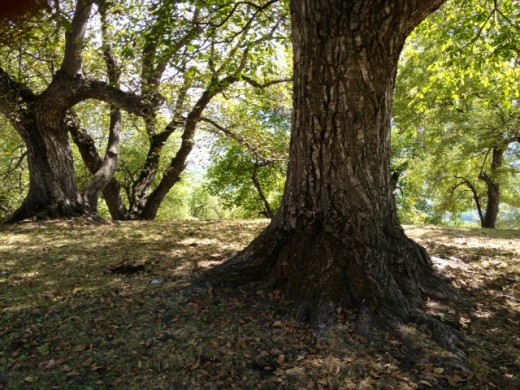Hi, this is Eliza and I’m sort of the new kid on the block here at Foggy Ridge. In early September of this year, I spent three weeks fruit exploring in the wild fruit and nut forests of Kyrgyzstan, the birthplace of apples (it shares this title with Kazakhstan). As a budding apple orchardist with a permit to import seed through the USDA, I had to see these fruit forests for myself.
My trip started off in the walnut forests of Arslanbob, Kyrgyzstan, where I had learned of an isolated population of apples growing with these walnuts. These walnut forests are the largest in the world (1.6 million acres) and have been popular ever since Alexander the Great took a bag of walnuts with him to Greece and named them Persian Walnuts. Most of the tourists who visit Arslanbob, which involves a 12 hour taxi ride, go to see these walnut forests. No tourists had ever called ahead about visiting these forests for the apples and this excited the folks at the Community Based Tourism (CBT) office. Wild apples are an undervalued resource in Kyrgyzstan and those with CBT were excited to see that an American was showing an interest. They were shocked when this American was a female, but that is another story.
On our first day (I was travelling with a Russian translator and a globetrotting chef), our guide took us deep into the high elevation apple-walnut forests ranging between 5000 and 6500 feet. Not having been in a forest like this before, I didn’t quite know what to expect. In the months leading up to this trip, I had imagined a mass of tangled perennials growing below old wizened apple trees, each species performing a purpose to keep the ecosystem in balance. After reading Gary Paul Nabhan’s visit to Kazakhstan, I also prepared myself for the smells of apples rotting on the forest floor. The reality of it all was far from what I had imagined.
The high elevation apple forests were a mix of walnuts (Juglans regia), apples (Malus sieversii) and hawthorn (Crataegus spp.) dominating the overstory. Instead of entangled perennial masses in the understory, the grass was closely trimmed and the occasional cow or sheep patty dotted the ground. The air was full of walnut smells, not rotting apples. The forest was seemingly manicured and devoid of dropped fruit or even sticks.

Apples growing underneath walnuts

Walnuts
Why was this? I was supposed to be in a wild jungle-like fruit forest!
I had forgotten about the people, who are an inextricable part of nature whether we like it or not. The Kyrgyz people are pastoral (some nomadic) with their diets heavy in meat and dairy. Almost everyone has livestock and the history of grazing their animals in these walnut forests goes back over 400 years. I asked my guide about the relationship between the Kyrgyz people and the walnut forests and he told me the following:
“[The walnut forests are sacred to us. The insects don’t like the smell of the walnut leaves, which keeps them away from our animals and our apples. The apples that drop to the ground with insects inside get eaten by the animals. The grass eaten by the animals is anti-parasitic* and provides for a large part of their diet during the growing season. The animals fertilize these trees in return for nourishment and health. The short grass is also necessary for the walnut harvest in the fall, which is our main source of income.]”
Suddenly, I realized that this place is not just a walnut-apple forest, but an integration of people and animals with food and income producing trees. It is a wild orchard, planted by no one and cultivated by everyone over hundreds of years! This made me really excited. I am the type of orchardist who dreams of not having to spray the orchard with anything and having nature do the hard work. Perhaps this could be a reality one day or maybe I’ll have to keep dreaming. We’ll see, my wheels are turning!
-Eliza
Soon to come: A variety of fruit entries (wild apples, pears, apricots, seabuckthorn, etc) along with some cultural tid-bits thrown in. Stay tuned!
*After some thought and research, I think the anti-parasitic qualities in the grass below the walnut trees contains some juglone, which is a natural chemical produced by walnuts that is known to be anti-parasitic and also somewhat toxic to other plants.



Thank you Eliza!
Will be sharing. Love your EntwinedLife thinking!
Hoping to bring a group from JC Raulson Arboretum to visit Foggy Ridge!
Eliza-
I enjoyed our conversation in the NEH Library today (12/20/2013). You are doing wonderful work and I am impressed with your research and its focus on sustainability. Maybe the leaves of the walnut tree, and/ or the shells of the walnuts can be used as a source of the anti-parasite substance(s). Ground up and put under the apple trees. The anti-parasite(s) might also be extracted from the fibrous organic matter and used prn. The methods of extraction in solution are most assuredly straightforward.
You will certainly make your mark and it will be important!!!
hi great post.
are the walnuts there different from the ones sold in other places eg i am in australia
I was always under the impression that walnuts were toxic and inhibitory to apples and that they shouldn’t be planted anywhere within the crown or rootzone of one another. Is this mistaken, or are these apple trees negatively affected, but it’s just part of the deal? Alternatively, are these apples resistant to the allelotoxins?